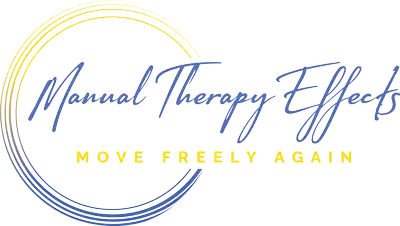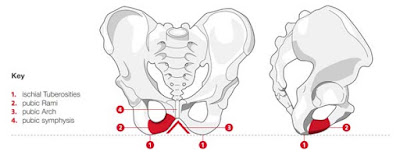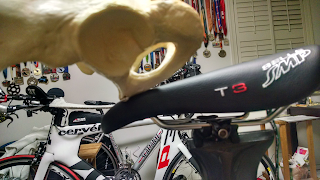This is the continuation of a series of posts on bike fitting and saddles from the perspective of your resident triathlete and physical therapist.
As the date of my next meeting with Chris neared, we, unfortunately, rescheduled. A blizzard along with 2 feet of “historic” snowfall slammed our area basically shutting the whole region down for days. ARGH!! Everything was perfectly planned out…stupid snow. My nether regions were getting a bit…irritated and looking for relief. I was on my own to try the next saddle.
-Specialized Power (Sourced from another shop since Chris is not a dealer for this brand): really firm, narrow in the nose (38mm), a bit more T shaped/pear, hmmm….the ridges of the cut out were blunt and the lady bits were none too happy. Nose riding was not too comfy. This saddle seems to be designed more for sitting on the middle/rear and doesn’t allow me to rotate my pelvis the way I want. The semi rubber like outer was interesting. Good for minimal sliding on the saddle and a seemingly durable material for wet butts. In the end, my time with the Power saddle lasted 45 minutes with some tinkering, it just wasn’t going to work. I told Chris, “No Bueno.” He encouraged me to try again, but I just knew that I’d just be miserable and wasting my time. Back to the Terry until I saw him again in another two weeks…stupid snow. It would be a long two weeks.
Back to the fitter…(meeting 4, about 2 ½ months after my first visit)
Chris seemed more optimistic about the next one and eager to find out my impression of it. I, too, was hopeful, but tentative.
Here goes…
-Selle SMP T3: great concept, deep cutout the length of the saddle, more triangle than pear shaped, narrow through the nose with gradual widening, looks cool, but will it work? My initial feel, “not bad.” We dialed in the tilt and I pedaled away at the shop. I’m not joking when I say I pedaled away. For nearly two hours, I pedaled at a moderate effort dripping in sweat (it’s a good thing I’m an Ironman athlete, other folks may not have gotten too far). Chris circled me like a shark, observing and listening as I rode. He pressure mapped it. By far, the best mapping of all the saddles we tried, but no matter what the maps show, my nether regions had the final say.
For the 2 hour session, with a few breaks to tweak and saddle map, all was fairly comfortable, like couch comfortable. I quietly and cautiously thought to myself, maybe this is “The One.” Chris was kind enough to let me borrow the saddle for however long I felt I needed to try it or just out right buy it if it worked out. He may have sensed that I wasn’t sold on this saddle and wanted me to really try it out before I plopped any money down. He already knew I was hell bent on finding the right saddle and I’d be back at some point.
For 3 weeks and close to 300 miles or so, I gave it a go, tweaking (saddle forward/back, up and down, millimeter by millimeter) and riding, but I could never find that “couch” feeling I had at the shop. Each ride left me more and more discouraged as my frustration mounted. There were few options left out on the market that might work for me.
I emailed Chris throughout the trial period giving him feedback on the saddle. He always openly appreciated my feedback as he wanted to help in any way possible, or I was driving him nuts with this saddle issue of mine.
Chris and I spoke several times on the phone to discuss the saddle issue and come up with a different game plan. He was out of ideas and I was tired to having to deal with this issue. There had to be an answer. I needed some time away from the bike for a few days to decompress and then start up again. The weather was half way decent, so I spent it running instead of cycling. Nothing better than getting outdoors to clear the mind. Now only if it was consistently 75 and sunny…
 |
| My “before” in action photo. The red line denotes the “spinal take off angle” referenced. |
Not one to really give up easily (persistence can be a dangerous thing), my physical therapist brain started to kick in on the anatomy side of things. What was going on and why don’t any of these saddles work for me? At the office, I stared at my life size spine/pelvis model picturing in my head how it would sit on the saddle. I remember watching a bunch of bike fit analysis videos critiquing the bike fits of the top PROs at Kona. They spoke of “spinal take off angles” as it relates to pelvic tilt, see photo above. It got me thinking…”what is my spinal take off angle? I know I anteriorly rotate my pelvis a good deal on the saddle, but how much and how does that translate to where my pelvis is actually sitting on the saddle??”
I left my office that day with my plastic life sized model and goniometer in hand to do a few tests at home. I asked Chris to send me pics of my fits so I could further analyze my positions. I measured my sacral angles from all of my fit pics (pre fit, post fit day one, and post fit lower cockpit) it was around 40 degrees relative to horizontal. I checked a few old race pics on my old race bike and the new one, both were around 40*. Hmm…no matter the saddle to pad drop, or saddle tilt, I was still at 40*. So what does this mean as far as what was actually contacting my saddle??
I set up “Bones” on the SMP T3 saddle that was still on my bike. In aero, my pelvis teetered on the pubic bone (symphysis) therefore focusing all the pressure on that small area, top photo, above. When I found the sweet “couch” spot, the contact point closer to the nose of the saddle, my weight distributed more on the rami while the pubic bone had some relief as the nose swooped downward, bottom photo, above. Hmmm…interesting.
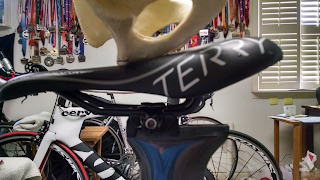 |
| The sweet spot on the Terry above the cut out. |
Curiously, I moved “Bones” to the trainer bike (old race bike) which has a Terry saddle on it and found a similar result. Interestingly, I later found the sweet spot of the Terry was towards the rear of the cutout where my rami were actually a little more supported. I could tolerate that saddle if I rode on the saddle in this manner but I was still irritating the soft tissue to the front because the nose was in the way. When out of aero position, my sacral angle was around 45* and I’m happily sitting on my rami with the saddle cradling my pelvis.
I shared my “findings” with Chris as he found my theory pretty interesting. I pointed out that guys don’t really have this problem since the “boys” are in this anatomical region of their bodies blocking them from really rotating as far forward as my pelvis. Guys tend to sit more in favor of their pubic rami or their ischial tuberosities (for those with flexibility issues) in aero position. I sent photos to Chris so he knew what I was talking about. So with all this in mind…the one saddle that came to mind that might match my criteria to support the rami, but keep me off my “junk” so to speak was the Cobb Gen2. Not wide, not too narrow, swooped down nose….maybe?? There was one other saddle out there that may work, but it would be an expensive experiment if it didn’t work. A $300 saddle with no return policy. Um…yeah…let me think about that. I contacted the company (a US based one) and the owner basically said, no returns. It becomes a really nice and very expensive paperweight if it doesn’t work. I don’t have that kind of money to throw around (I am taking donations…).
For kicks, I threw my stock ISM Adamo Prologue saddle on my bike. I did a 60 minute session on it, tweaking it as I went along. While I get how this saddle would work for those that love this saddle, I found it a touch too soft, and it flared out way to too much from the nose back, much like the ISM Adamo Attack saddle (except the Attack was firmer). Even hanging off the front like you’re supposed to, the width of the saddle going back hit in all the wrong places (namely the crease of my leg and groin, which was not too happy with me by the end). Also the pressure, more like pain, on my right side down there…yeah, um… oh HELL no. SO….back on the Terry I went. If I was going to be uncomfortable, then please let me be on a saddle where I at least know what to expect and just tolerate it. I informed Chris of my findings with all of this and we scheduled yet another time to meet.
I emailed back and forth with Chris for a week about this and he was taking my lead on this theory. He kept telling me that he’s here to help in any way possible. We both had invested an enormous amount of time and energy into figuring out my saddle issue. Mind you, I’ve only paid him for my initial fit and all the work that has been done to the bike (cranks and cockpit install). Chris wanted this fit right and really cared about my comfort on my bike (remember the passion and pride thing?). In this day and age, customer service died a slow death years ago, perhaps decades. Chris had definitely gone above and beyond for me; it was WAY more than I ever expected. He could have easily just said “I can’t help anymore,” blew me off, and let me go on my way with a bike fit that was only partially complete. This was HIS body of work and he wanted to reach a happy outcome. It seemed as long as I was willing NOT to give up, he would be there to do what he could to help me. I was grateful (more than he realizes) knowing I wasn’t alone in my saddle struggles.
In the meantime, I contacted the nice folks over at Cobb Cycling, namely the women’s specialist, Rachel. I wanted more intel on the Gen2 and maybe the Fifty Five saddle. I also sought validation of my findings (my “theory”). She replied pretty quickly and gave me a ton of feedback. She understood everything I had told her about my situation and made her recommendations to me. I’m not sure they actually put a sacral angle number to that “point of no return” tipping on your pubic bone or happily sitting on you rami, but she knew what I was talking about.
FOUR months into this process (and has it been a process) I’m back again meeting with Chris for the FIFTH time. Honestly, I didn’t think the process would be this long, I’m sure he didn’t either. Feeling like we were beating our heads into a wall, we both had committed; Too far to turn back and we both wanted to have the best outcome. We discussed my renewed time with the Terry. It was more data to add to the mix of what was working and what wasn’t. Based on my position and my observed feedback on the Terry, we decided to start with the noseless saddle first, the Cobb Fifty Five (the first saddle Rachel recommended to me). Now, we were both trying to reserve our optimism since we haven’t had a lot of luck finding “The One.” Time to see how the next two saddles work out…
-Cobb Fifty Five JOF: initial first contact impression…hmmm…not bad. No abnormal pressure points, really not a lot of anything. I didn’t think about the width of the nose or where I contacted the saddle; I was just sitting and pedaling. The saddle seemed to disappear. Chris, again, circled me like a hawk, studying my position and body interactions from all angles. For a good two hours, I pedaled and gave feedback about the saddle and the position. We really didn’t tweak much from where it was mounted from the start. My nether regions were quite happy.
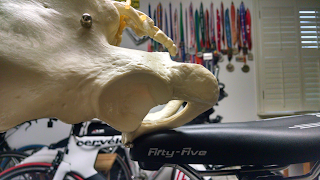 |
| My pelvic rotation position on the Cobb Fifty Five JOF. Seems like it would work. |
At the first sign of soft tissue discomfort (it took a while, and it wasn’t in the obvious spot. The point of discomfort was closer to the crease of my groin.), Chris wanted to pressure map it. It mapped better than most of the other saddles we had tried. I didn’t want to jinx it, but part of me was thinking this could be the “where have you been all my life” moment with a saddle? Honestly, its probably the best saddle I tested. Sitting up out of my aero bars, I was reasonably comfortable with the 135mm seat width in the back and provided enough support (even though I don’t really rotate my pelvis back far enough to contact my ischial tuberosities). My pubic rami were supported in an upright position as I found a couple of areas on the saddle I could sit on with little issue when climbing. Despite its width in the nose (at 55 mm, the one thing that crossed it off the list early on so it never resurfaced on the radar), I didn’t really feel it. It was VERY different than the Adamo saddles, even though the nose widths were similar, the shapes of the saddles made them distinctive.
Meanwhile, I brought up another bothersome bit of my fit: my left foot numbness (an ongoing issue well before this whole process began). While I tested the saddle, Chris and I discussed what he could do to help eliminate the numbness. I provided feedback constantly about it. He tweaked one thing, we tried another. I already had Superfeet inserts in my shoes, a metatarsal gel pad, and cleat wedges (Chris had put these on prior to this foot only). While I’m not sure we eliminated the numbness (more ride time on my home trainer will be more telling) we decided on a more rearward placement of my cleats (in between the traditional and true midfoot/arch positioning). There were a few things we discussed that I could try on my own. I’m not quite ready to commit to custom cycling shoes at this point. It would mean a minimum of $1k to get custom shoes….um, no (again, donations are being accepted).
Now despite testing well and the beginnings of perhaps a lasting relationship with the Cobb Fifty Five, we tested the next saddle to completely rule it out.
-Cobb Gen 2: A more traditional saddle shape, firm, split nose with a 47 mm nose width. Its definitely long in the nose with a longer downward sloping nose at the tip. We set it up per Cobb’s recommendation on the tilt. First impression: hmmmm…not sure I like this. Immediate pressure and discomfort in places I was trying to avoid. It did not map well. After maybe 10 minutes, I was done with this one. No warm fuzzies.
We decided to give the Fifty Five a go and keep trying to figure out how to relieve the numbness in my left foot. Again, Chris let me “borrow” this saddle until I ultimately decided it was a “take my money!” moment or I whimpered back to the shop completely discouraged in the search for saddle relief and give it back. On my way out of the shop, I stated to Chris, “I like to think of this whole experience as one of those memorable lifelong learning experiences (from the professional/career thing). I have learned more about bike fitting than I really ever wanted to know.” However, we weren’t done. We were both going to see this to the end or go crazy trying.
A new hope?
In my optimism and eagerness to try the saddle, I hopped on the bike the day after my session with Chris. Bad idea. Why? Let’s just say the saddle time was not a pleasant experience. The glorious couch feeling at the shop was nowhere to be found. UGH!!! Immediately, I flashed back to my time with the SMP saddle. Not again. A comfy couch at the shop, and the next time I rode (which was days later) it was torture. I never really found the comfy couch feeling again riding the SMP and it was happening all over again with the Cobb Fifty Five. Dammit!!! I sucked it up for the ride, but realized the soft tissue (despite feeling totally fine after my initial test ride) had not recovered. It was definitely sensitive and not in a good way. I declared that I was an idiot for doing what I did, all because the weather was “too cold” for me to get my run workout done (and for me, temps in the low 40’s…is too damn COLD). I flared up one little hot spot into a larger area of irritation and mentally, I began to question this saddle and its possibilities. I didn’t want to confess to Chris what I had done as I wanted to give it a few more rides before reporting in.
So, in some moment of desperation, I reached out to the folks at Cobb Cycling to help me and Chris (indirectly). By doing so, I felt like I was cheating on him. I wasn’t looking for validation of Chris’ work on my overall fit (I know it was mostly dialed in), I wanted COMFORT on my SADDLE!!!!! We needed another set of eyes. Since I was trying one of their saddles, I thought maybe they SHOULD know best in terms of how to dial the saddle in most effectively, and just maybe they could help with my foot numbness as well. I emailed back and forth with Rachel about what was going on. I sent them photos of my bike, my fit and eventually videos of my pedal stroke from all angles to ascertain what in the world was going on. I waited eagerly for their feedback that perhaps we might come to some resolution.
During this time, I had gotten a 2nd shorter ride in two days after my “mistake.” It was a little bit better, but my hot spot was not happy with me and my foot was still going numb. However, I still needed time away from the bike to let things settle down and recover more. It definitely didn’t have the couch feel from the shop. Fortunately, the weather cooperated and I was able to get my runs in without stressing over whether I was getting my bike training in.
Rachel asked John Cobb to look over everything and make his recommendations to dial in the saddle position but also help my foot numbness. Per Cobb’s recommendations, move saddle forward (2cm), and drop the saddle a little (5mm). Who am I to argue with a guru in the industry who’s been pioneering stuff longer than I’ve probably been riding a bike as a kid? He also had me flip the cleat wedges from their original orientation (varus to valgus) to help ease the left lateral foot numbness.
I kept Chris in the loop as he was interested in what they had to suggest. The cleat wedging recommendation left Chris a little puzzled as to why you would do this. It was contrary to what he learned/trained to do. Initially, I was a bit perplexed, but as my PT brain kicked in, I had a feeling it had to do with other biomechanical components up the kinetic chain (away from my forefoot and more my rearfoot). After digging through my archives, Cobb’s method made sense, in theory, for a walking/running foot contacting the ground (there are studies that support this). It most definitely had to do with altering other aspects of my foot mechanics to help “align” other parts of the kinetic chain. There is more technical, anatomy jargon to explaining all of this which is more than most people want to know. Basically the best way to describe it, by improving the mechanics of a critical part of the chain of the foot/ankle complex, it causes a shift in how one weight bears through their forefoot. In my case, it shifts from lateral (pinky toe) to more medial (towards big toe) dispersing the pressure across my foot rather than just one spot (lateral foot). BUT how does that translate to a foot that is locked in a shoe fixed to a pedal??
My next ride with all of the recommendations from Cobb, sadly, did not really improve things. In fact, it stirred up some nigglies that were dormant for years. It got ugly. As I later wrote to Chris, “what an f-ing disaster!” The intolerable saddle discomfort, the random nigglies cropping back up (both anterior (TFL) hip regions and my knee from the saddle being too low, my back from the shortened cockpit and posturing to find the sweet spot squirming all over the saddle), my left foot was still going numb, and a buildup of mental frustration over the course of 90 min ended what was supposed to be a 3.5 hour ride. I’ve never felt so uncomfortable on a bike than I did during this “ride.”
Systematically, over the 90 minutes, I put everything back to where it was before, but the damage was done. I begrudgingly got off the bike feeling utterly deflated, frustrated, annoyed, pissed, and disappointed all at the same time. So much so, I was on the verge of throwing in the towel. Overwhelmingly upset and beyond frustrated, I was literally left in tears with my emotions boiling over (and I’m not one to cry). All this time spent trying to find a saddle only to be back at square one. I initially emailed one word to Chris to voice what happened (it will not be repeated here, but it was a colorful 4 letter adult word, phonetically spelled without the last letter). He replied, “That does not seem to be good…” I gave him a brief reply to summarize how I was feeling and that I was instead washing and mini detailing my cars for therapy. So, I wasn’t sure if he’d try and call me to find out what happened or if he’d leave me be to bond with my four wheeled babies. Once I decompressed after the ride, I emailed Chris debriefing him of what happened.
At this point, I’m pretty sure Chris was feeling bad for me and really didn’t know what to say or do. Like most guys…they listen and look for solutions rather than express any emotions. There was nothing wrong with that as somebody had to keep calm and collected through all of this. Rather than getting sucked into my emotional saddle hunting roller coaster, he always looked at things objectively, maintaining his professional demeanor focusing on solutions despite my moments of hysteria (thanks for hanging in there with me!).
Time to regroup, wait for feedback from Cobb et al and Chris, and come up with another approach. In the meantime, I decided the hell with it. Time to wander out of the box a little. I put my saddle position back up to where Chris and I set it and tilted the saddle down a little more. Nothing about this process has fallen into the realm of the “normal”. I know nothing about me falls into the middle of the bell curve, so why would my bike fit be any different?? I also decided to try a different pair of shorts, hoping that maybe the chamois would make a difference. I hoped by accident I would fall into the sweet spot and balance would return to my cycling world. Stranger things have happened in my world of unexpectedness.
Holy hell, can we get this girl some comfort on her saddle!?!?
I can’t really imagine what Chris could possibly be thinking or feeling during this process. Well, maybe. I have tough cases I work with clinically, so I have an idea. I’m not sure where I’d be without his support and help with all this.
Part 5 continues with an interesting twist… is there an end in sight?
